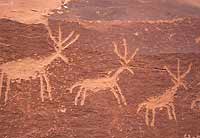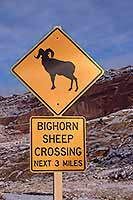Mule deer and the other large hooved animals such as bighorn sheep, pronghorn, mountain goats, and elk roam the canyons, plateaus, and mountains of southern Utah. Moose are nearby, having migrated from the state’s northern mountains down into the Book Cliffs, north of Interstate 70. 
The commonly observed mule deer gets its name from the large mule-like ears. These animals are widespread in the mountains, sagebrush flats, and canyons where they browse on shrubs and forbs.
Bucks grow antlers that are shed each year, often in the winter. By the end of summer, the males have antlers covered in velvet which is a thin layer of skin rich in blood vessels and nerves. Once the antler stops growing, this velvet covering will be shed and the bony antler exposed. The males use these antlers to joust during the rut when they gather a harem of does together.
Pronghorn live out in the open grasslands along Interstate 70 where they may be observed foraging on grasses or forbs. Their excellent eyesight enables them to detect predators from a distance, then leave them in the dust with the fast speed. The “horn” is a sheath that covers a bony core and is pronged at the tip giving these creatures their common name.
Rocky Mountain elk inhabit the mountains and high plateaus of the region. Their long legs enable the elk to move about in snowy areas where they feed on exposed shrubs and trees. During the growing season, these ungulates feed on grass and forbs. Like a mule deer, elk shed their large antlers after the breeding season. The La Sal and Abajo mountains are good places to see these large animals, but sometimes they come down into the foothills around Monticello.
Desert bighorns may seem scare during the summer, but groups gather together during the rut which takes place in the late fall. Males vie for dominance as they gather harems together. Younger males may be tolerated by the older males which sometimes engage in classic head-butting rituals that sounds like a rifle shot when they crack heads together. Potential places to view bighorn are in the Windows Section at Arches NP, the White Rim trail in Canyonlands NP, and in the talus slopes below Dead Horse Point SP (don’t lean too far over the edge!). Females have short horns and may be confused for a young ram.
Mountain goats are new to the desert scene. Recently introduced into the La Sal Mountains, these animals survive at higher elevations, eating alpine plants and lichens. An extinct Pleistocene species, the Harrington Mountain Goat, inhabited the region some 15,000 years ago, identified by fossil remains unearthed in nearby caves.
Keep an eye out for all these magnificent desert-dwelling creatures as you visit Canyon Country. Knowing where to look is key. Sometimes you might only see prints in the sand or droppings that indicate the passing of these animals through the area, but know that these hooved animals are out there and it just takes some time, luck, and patience to see them.


